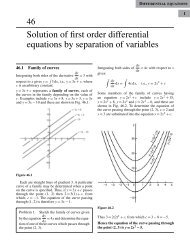trigonometry
Create successful ePaper yourself
Turn your PDF publications into a flip-book with our unique Google optimized e-Paper software.
144 GEOMETRY AND TRIGONOMETRY<br />
(a) Determine the angular velocity of the<br />
wheels in both rad/s and rev/min.<br />
(b) If the speed remains constant for 2.70 km,<br />
determine the number of revolutions<br />
made by a wheel, assuming no slipping<br />
occurs. [ ]<br />
(a) 75 rad/s, 716.2rev/min<br />
(b) 1074 revs<br />
Since θ = ωt then<br />
t = θ ω<br />
Dividing equation (1) by equation (2) gives:<br />
V<br />
t<br />
=<br />
2v sin (θ/2)<br />
(θ/ω)<br />
=<br />
vω sin (θ/2)<br />
(θ/2)<br />
(2)<br />
14.7 Centripetal force<br />
When an object moves in a circular path at constant<br />
speed, its direction of motion is continually changing<br />
and hence its velocity (which depends on both magnitude<br />
and direction) is also continually changing.<br />
Since acceleration is the (change in velocity)/(time<br />
taken), the object has an acceleration. Let the object<br />
be moving with a constant angular velocity of ω and a<br />
tangential velocity of magnitude v and let the change<br />
of velocity for a small change of angle of θ (=ωt)<br />
be V in Fig. 14.12. Then v 2 − v 1 = V. The vector<br />
diagram is shown in Fig. 14.12(b) and since the magnitudes<br />
of v 1 and v 2 are the same, i.e. v, the vector<br />
diagram is an isosceles triangle.<br />
For small angles<br />
hence<br />
V<br />
t<br />
However, ω = v r<br />
thus<br />
sin (θ/2)<br />
(θ/2)<br />
≈ 1,<br />
change of velocity<br />
=<br />
change of time<br />
= acceleration a = vω<br />
vω = v · v<br />
r = v2<br />
r<br />
(from Section 14.6)<br />
i.e. the acceleration a is v2<br />
and is towards the centre<br />
of the circle of motion (along V). It is called the<br />
r<br />
centripetal acceleration. If the mass of the rotating<br />
object is m, then by Newton’s second law, the centripetal<br />
force is mv2 and its direction is towards the<br />
r<br />
centre of the circle of motion.<br />
Problem 16. A vehicle of mass 750 kg travels<br />
around a bend of radius 150 m, at 50.4 km/h.<br />
Determine the centripetal force acting on the<br />
vehicle.<br />
Figure 14.12<br />
Bisecting the angle between v 2 and v 1 gives:<br />
sin θ 2 = V/2<br />
v 2<br />
i.e. V = 2v sin θ 2<br />
= V 2v<br />
(1)<br />
The centripetal force is given by mv2 and its<br />
r<br />
direction is towards the centre of the circle.<br />
Mass m = 750 kg, v = 50.4km/h<br />
50.4 × 1000<br />
= m/s<br />
60 × 60<br />
= 14 m/s<br />
and radius r = 150 m,<br />
thus centripetal force = 750(14)2<br />
150<br />
= 980 N.










